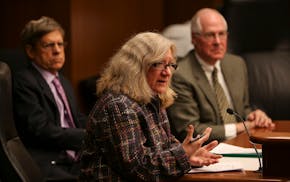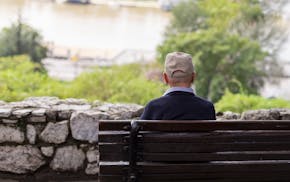Opinion editor's note: Strib Voices publishes a mix of material from 11 contributing columnists, along with other commentary online and in print each day. To contribute, click here.
•••
Welcome to spring, that wonderful time of year when a significant portion of Minnesotans emerge, blinking from hibernation, suddenly remembering that the outdoors exists. Unfortunately, the outdoors is not always cooperative.
That was the situation I found myself in a couple weeks ago as I wrapped myself in a coat to go hang out in drizzly, windy, 50-degree weather with a bunch of strangers. The reason: "Queers Eating Garlic Bread in the Park," a fairly self-descriptive event I learned about from an anonymous flyer circulating on social media. "No RSVP!" the flyer promised. "No agenda! No organizer! BYOGB! Be a nice person!" There was also no specific location, beyond a vague hand-waving toward Powderhorn Park at 4 p.m. In my defense, this all seemed a lot more reasonable when I thought it was going to be warm and sunny.
But despite the bad omens, this event turned out to be exactly what I needed. The cold weather made it fairly easy to spot the correct group of people milling around a picnic table. When I arrived, I was greeted warmly by strangers … as well as three friends I didn't even know were going to be there. Over the course of an hour and a half, friends and strangers drifted in and out of the group, including a pack of random teens who just wanted free garlic bread. The vibe was welcoming and open, and felt a little like the first days of college when it's possible to walk up to folks you don't know, have a good conversation and realize later you forgot to exchange names. And, yes, the garlic bread was delicious.
This thing that maybe should have been awkward and uncomfortable was, instead, magic. And I think the pixie dust in the equation was a park actually being used as a "third place." You've probably heard that term quite a bit over the past few years. Since COVID-19 temporarily (and in some cases, permanently) shifted society toward a higher degree of home-bound isolation, "third places" have become the way we talk about the social lives we miss. Often, people use the term to just mean somewhere that is not your house or your office, but where you can meet up with others. Those queers eating garlic bread in the park, however, reminded me that the concept of a third place is about more than a location. A park could be a third place, or it might not. It all depends on how it's used.
Ray Oldenburg, the urban sociologist who came up with the term, was careful to include this kind of nuance in his original definition. The difference has to do both with how the space is managed and presented, and with how the people who show up there choose to use it. Back in 1989, he outlined seven characteristics that made a third place: It's open and inviting, comfortable and informal, convenient and unpretentious. It has the presence of "regulars," conversation is the main activity and laughter is frequent.
But those seemingly simple guidelines don't necessarily pin the thing down. Oldenburg and his co-author Karen Christensen went on to spend decades writing about third places, always refining the idea. For example, Christensen now draws a line between third places (where you're likely to engage in conversation with regular acquaintances and strangers) and public places (where you and the people you already know get together and hang out). Some of her writing even explicitly lists "parks" as a public place, rather than a third one.
In some ways, that makes sense. A lot of the ways we use parks are as extensions of our own backyards. We walk our dogs. We sunbathe. We play basketball with friends. We do those things in public, but not as part of "a public." And there are also ways that the management of parks sometimes excludes people and makes the place less convenient, something a true third place wouldn't really do — like removing benches, fencing off grassy fields or shooing away inconvenient gaggles of teens. You can't go somewhere everybody knows your name if there's nowhere to sit.
But we also all know, innately, that parks can be third places. After all, that's how kids use them. My children go to North Commons Park when they're bored with the house or bored with me because there are almost always other kids milling around, equally bored, who will play a pretend game about the dragon-kittens ("drittens," if you will) who live at the top of Doom Mountain. We all remember how great that feels — to show up somewhere, engage with people we may or may not ever see again, and just have a blast being ourselves, together.
That's the feeling the garlic bread party recreated for me. I think it's something a lot of us often forget that we're hungry for. (The sense of community, I mean … everyone always knows they're hungry for garlic bread). Discourse about third places often seems to focus on how much nicer life would be if we had more coffee shops or longer library hours without considering that the good life is about more than just a place to go. "Joy in living depends upon peoples' capacity to enjoy the company of those who live and work around them," Oldenburg wrote. And that can't happen if our public places don't make it easy — or if we don't take the initiative to, on occasion, make a weird flyer and start posting it in community groups.
None of us who showed up that day ever did find out who initiated the Minneapolis queer garlic bread meetup. No one at the event would cop to making the flyer, and the creator may not have attended at all. But whoever they are, they made a little place where (to paraphrase another Oldenburg banger) we could be open to the community, rather than protected from it. And maybe, if I'm lucky, that'll happen again. Just this week, I saw people talking in a Facebook group about maybe having a second helping of garlic bread (and joy) in June.

Fierce but compassionate mental health advocate will be missed
Dabney: The plan to raise Minnesota's cannabis tax to 15% will fuel the black market
Opinion: The ever-expanding definition of 'fake news'

